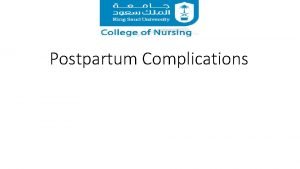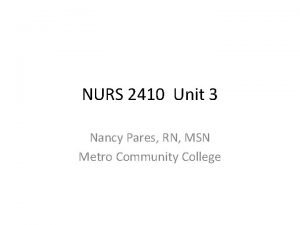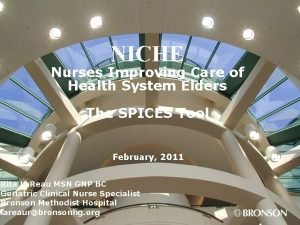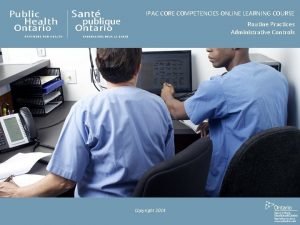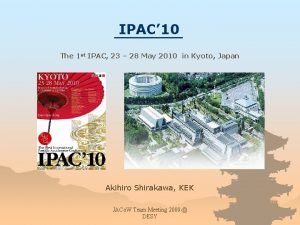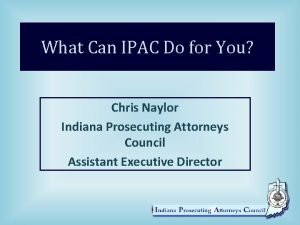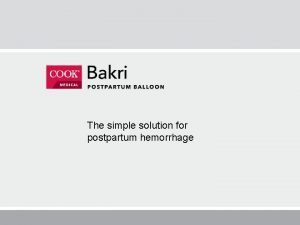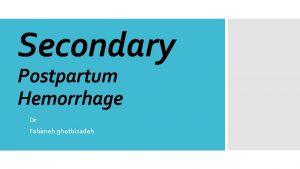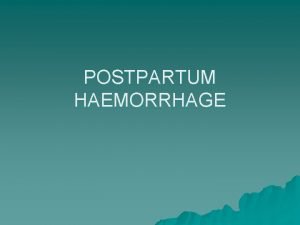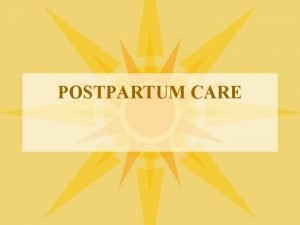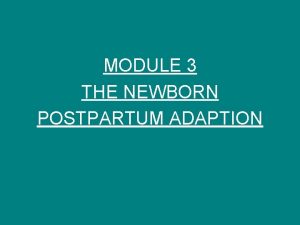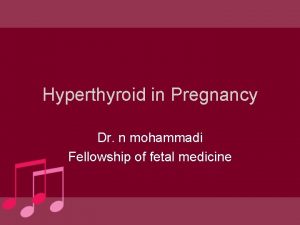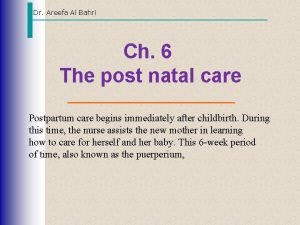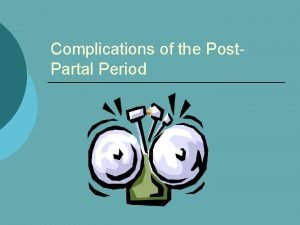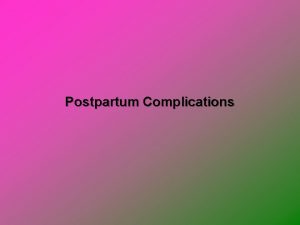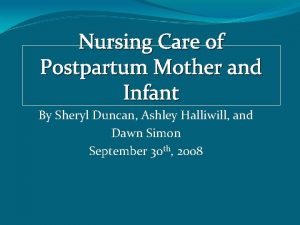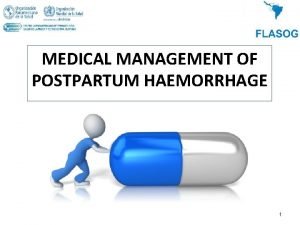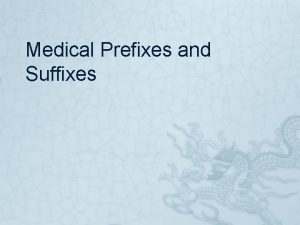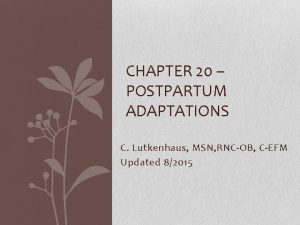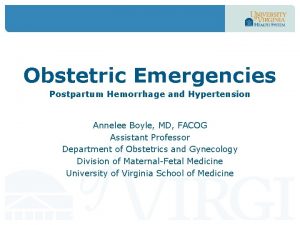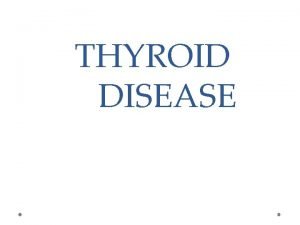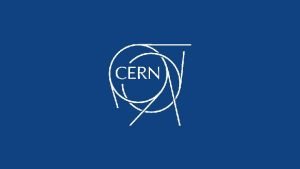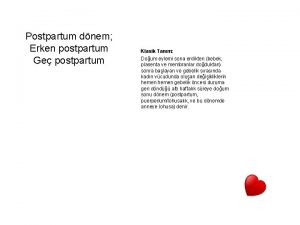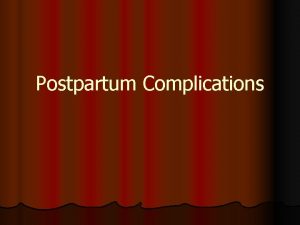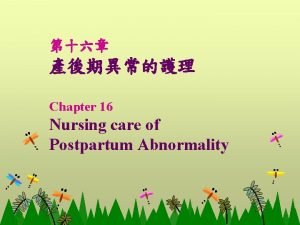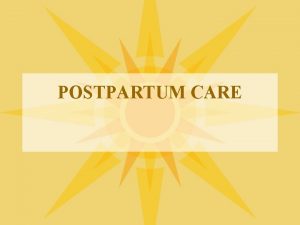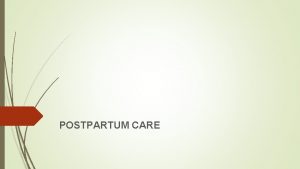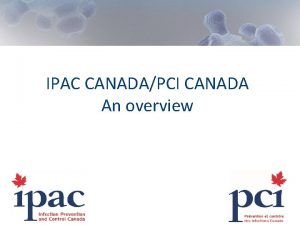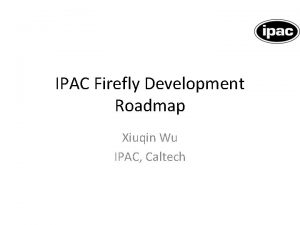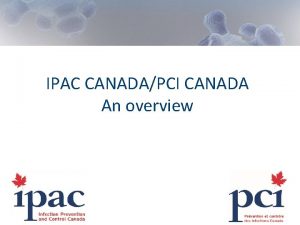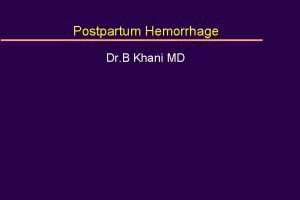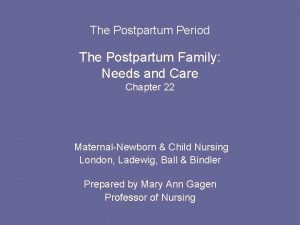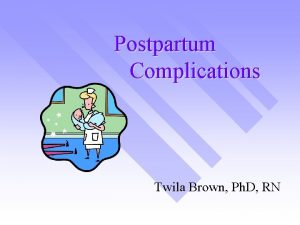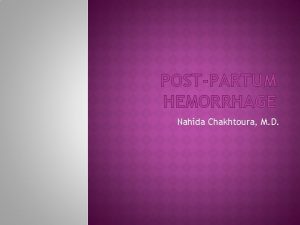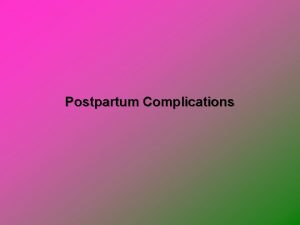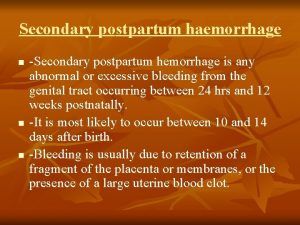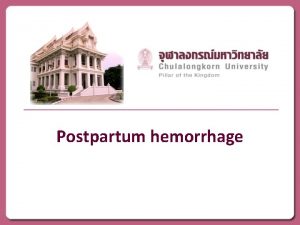Improving Postpartum Access to Care IPAC WHY IPAC































- Slides: 31

Improving Postpartum Access to Care (IPAC)

WHY IPAC MATTERS? 2

Redefining Postpartum Care ACOG Committee Opinion #736: • To optimize the health of women and infants, postpartum care should become an ongoing process, rather than a single encounter • All women should have an early postpartum visit q q Blood pressure checks Breastfeeding support Mental health well-being Contraception • Initial assessment should be followed up with ongoing care as needed • Followed a comprehensive postpartum visit between 6 -12 weeks 3

REVIEW OF MMRC REPORT 4

Key Recommendations from the MMRC report • For Providers: • Providers should adopt the recent recommendation from the American College of Obstetricians and Gynecologists (ACOG) for early postpartum visit in addition to traditional 6 week visit • For Hospitals: • Birthing hospitals should ensure that women are connected with a primary care or obstetrical provider and scheduled for a postpartum visit prior to hospital discharge • For Health Plans: • Illinois should expand Medicaid eligibility for the postpartum period from 60 days to one year after delivery and health insurance plans should cover case management and outreach for postpartum high-risk women for up to one year after delivery • Health insurance plans should separate payment for visits in the postpartum period from labor and delivery (unbundle postpartum visit services from labor and delivery) http: //dph. illinois. gov/sites/default/files/publicationsowhmat ernalmorbiditymortalityreport 112018. pdf 5

MMRC Report Overview • IL is first state to release a statewide maternal morbidity and mortality report • Identified statewide trends in maternal mortality and provided recommendations to prevent maternal mortality • Key Findings: • Avg of 73 women per year died within one year of pregnancy 2008 -2016 (Total of 655 women) • Non-Hispanic Black women are 6 x as likely to die of a as non-Hispanic White women • 72% of pregnancy-related deaths and 93% of violent pregnant-associated deaths (includes overdoses) were deemed preventable 6 http: //dph. illinois. gov/sites/default/files/publicationsowhmat ernalmorbiditymortalityreport 112018. pdf

Key Findings Regarding Maternal Mortality in the Early Postpartum Period 24% of pregnancy associated deaths 0 -42 days 53% of pregnancy related deaths 0 -42 days Before the 6 week visit http: //dph. illinois. gov/sites/default/files/publicationsowhmat ernalmorbiditymortalityreport 112018. pdf 7

Maternal Morbidity in the Early Postpartum Period • 50% of postpartum strokes occur within 10 days of discharge • 20% of women discontinue breastfeeding before the first 6 -weeks • Up to 40% of women do not attend the 6 -week postpartum visit • As many as 1 in 5 women experience a postpartum mental health disorder 8

New Postpartum Care Continuum An early postpartum visit (within 2 weeks of delivery) provides women with essential maternal safety checks such as blood pressure evaluation, wound/perineum evaluation, breastfeeding support, mental health well-being, and family planning, among other essential health services. 9

Components of the 2 week Early Postpartum Visit Maternal Health Safety Check q q q q Blood pressure / preeclampsia symptoms check Wound/ perineum check Assess appropriate postpartum bleeding Mood check/depression screening Breastfeeding support Family planning/contraception options Linkage to health / community services (ie. WIC, breastfeeding support, home visits) q Assess medical / pregnancy complications, including SUD/OUD risks and link to needed follow up care q Review risk reduction strategies for future pregnancies 10

ILPQC STRUCTURE AND SUPPORTS 11

Illinois Perinatal Quality Collaborative (ILPQC) • Multi-disciplinary, multi-stakeholder Perinatal Quality Collaborative with 119 Illinois hospitals participating in 1 or more initiative • Support participating hospitals’ implementation of evidenced-based practices using quality improvement science, collaborative learning and rapid response data >99% of IL births 12

ILPQC Provides Responsive QI Services to Hospital Teams Webinars/ Calls Face to Face ILPQC Resources ILPQC Data • Monthly collaborative learning calls • Quarterly QI support calls to individual teams • Small group QI topic calls as needed • Spring Face-to-Face Meeting breakouts • Annual Conference breakouts • Key Player site visits • Grand Rounds presentations • Paper/online QI toolkits • Patient-education materials • Monthly enewsletters • Webinar recordings • Rapid response data system • Real-time reports for teams to compare data across time & hospitals • Data system training calls Quality Improvement Support Services

Improving Postpartum Access to Care (IPAC) INITIATIVE OVERVIEW 14

ILPQC Improving Postpartum Access to Care (IPAC) Initiative Aim: Within 11 months of initiative start, ≥ 80% of participating hospitals will implement universal early postpartum visits (within 2 weeks) and be able to facilitate scheduling prior to hospital discharge To optimize the health of women by increasing access to early postpartum care within the first two weeks postpartum to facilitate follow-up as an ongoing process, rather than a single 6 -week encounter and provide an opportunity for a maternal health safety check and link women to appropriate services. Key Goals: • Increase % of women with an early postpartum visit scheduled with an OB provider within the first two weeks after delivery • Increase % of women receiving focused postpartum education prior to discharge after delivery • Increase % of providers / staff receiving education on optimizing early postpartum care • Achieve GO LIVE goal to provide IPAC for ≥ 80% participating hospitals by May 2020

Track progress with system changes, process and outcomes across time and compare to other participating hospitals HOW DO WE TRACK PROGRESS TO MAKE SURE WE ARE MAKING CHANGE HAPPEN 16

Aims & Measures Overall Initiative Aim Within 11 months of initiative start, ≥ 80% of participating hospitals will implement universal early postpartum visits (within 2 weeks) and be able to facilitate scheduling prior to hospital discharge Structure Measures IPAC protocol/process flow in place for facilitating scheduling of early postpartum visits with affiliated outpatient care sites and OB providers prior to discharge Communicate recommendation/strategy for early postpartum visit and obtain buy-in with OB providers/ outpatient care sites (ie, share ILPQC OB provider/outpatient care site packet) Implement standard postpartum education prior to discharge after delivery regarding: a) b) c) benefits of early postpartum care postpartum early warning signs and how to seek care benefits of pregnancy spacing and options for (outpatient) family planning Process Measures Educate all providers and staff on optimizing early postpartum care including: a) b) c) d) e) maternal safety risks in the postpartum period benefits of early postpartum care/maternal health safety check protocol for facilitating scheduling early postpartum visit prior to discharge documentation and billing for early postpartum visit components of early postpartum visits/maternal health safety check Outcome Measure Increase % of women with documentation of an early postpartum visit/maternal health safety check encounter scheduled within the first 2 weeks of delivery Increase % of patients who receive standardized pp patient education prior to discharge 17

ILPQC Data System Collect data at your hospital Enter data into data system Review your progress in webbased reports to compare across time and across participating hospitals 18

The QI team at your hospital will be collecting and sharing data for this initiative Paper form 19

Timeline for IPAC Go LIVE goal by May 2020 Initiative Development and Pilot with St. Anthony Hospital Recruitment for IPAC Teams April – December 2018 Winter/ Spring 2019 IPAC Kick-Off Call Wave 2 Launch Face-to-Face Meeting Monthly Team Webinars / Active QI Period May 20, 2019 May 29, 2019 3 rd Monday of month, 11 -12 pm 2019 -2020 20

IPAC Clinical Leads • Clinical Leads: – – Michelle Bucciero, St. Anthony Hospital Jeanne Goodman, Loyola University Medical Center Kelli Lewis, Franciscan Health Olympia Fields Lisa Masinter, Erie Health Center • Clinical leads work with ILPQC to develop and refine data project aims/measures, data collection, scope, etc. 21

IPAC Key Driver Diagram AIM Within 11 months of initiative start, ≥ 80% of participating hospitals will implement universal early postpartum visits (within 2 weeks) and be able to facilitate scheduling prior to hospital discharge Key Drivers Utilize provider outpatient packet to engage OB providers and outpatient care sites to help plan for early pp visit scheduling, obtain buy-in from providers, and share options for billing and coding. Implement process flow to facilitate universal scheduling of early pp visits prior to delivery discharge Implement provider and nurse education on risks of the postpartum period, benefits of early pp visit, and key components of maternal health safety check Standardize system to provide patient education prior to hospital discharge on the benefits of early pp visit, early pp warning signs, and benefits of pregnancy spacing and options for (outpatient) family planning Strategies Obtain buy-in from OB providers and outpatient care sites on national recommendations and benefits for an early pp visit within 2 weeks. Provide billing and coding information to OB providers and outpatient care sites for the early pp visit within 2 weeks. Create a hospital specific process flow to help facilitate scheduling of an early pp visit within 2 weeks prior to discharge Revise policies and procedures to ensure scheduling for an early pp visit within 2 weeks Develop strategy to educate inpatient and outpatient providers and staff using IPAC slide set, OB Provider Packet, and/or didactic education Plan in place for ongoing and new hire education Patient education materials selected: benefits of early pp visit/ components of maternal health safety check, early pp warning signs and how to seek care (AWHONN), benefits of healthy pregnancy spacing/(outpatient) family planning options Implement system to provide and review IPAC patient education prior to hospital discharge 22

Process Flow for Scheduling Early Postpartum Visit Patient meets all discharge criteria Patient counseled on need for early postpartum visit at 2 weeks and will help make appointment before discharge Provide patient education materials on the benefit of early postpartum visit, warning signs/symptoms to seek care (ie. AWHONN hand out), and information on benefits of pregnancy spacing/family planning options. ) Able to schedule early postpartum appointment before discharge No Arrange follow up with patient to schedule 2 week postpartum visit after discharge Yes Appointment scheduled and appointment date and time added to patient’s discharge paperwork Document counseling, education and postpartum care plan in discharge summary / instructions and ensure patient has follow up plan Confirm patient has early pp visit scheduled and document in record 23

Your OB Provider Packet What’s included in your packet • Initiative introductory letter signed by your OB Chair • Your hospitals discharge process flow • IPAC Fact Sheet • National and State Guidance documents – ACOG CO #736 – AIM Postpartum Care Safety Bundle – IDPH Maternal Morbidity and Mortality Report • Billing and coding resources • Provider education resources • Office Flyer 24

Early Postpartum Visit/Maternal Health Safety Office Flyer 25

Early Postpartum Visit/Maternal Health Safety Checklist 26

Example Postpartum Patient Education Material 27

What is the role of the OB provider for IPAC success? • Council all patients on the plan for early postpartum visit and why a maternal health safety check within 2 weeks is important (discuss key components of visit), document plan/discussion • Make sure patient receives pp education material before discharge: – Benefit of early postpartum visit – Postpartum early warning signs and how to seek care – Benefits of pregnancy spacing, family planning options • Facilitate scheduling early postpartum visit (within 2 weeks) for all patients, document in chart • Confirm patients receive early pp visit within 2 weeks/ maternal health safety check and use check list for key components • Document and bill for early postpartum visit 28

What is the role of the OB Nurse for IPAC success? • Understand maternal risks in the postpartum period and benefits of early postpartum visit / maternal health safety check • Make sure patient receives pp education material before discharge: – Benefit of early postpartum visit – Postpartum early warning signs and how to seek care – Benefits of pregnancy spacing, (outpatient) family planning options • Facilitate and help ensure scheduling early postpartum visit (within 2 weeks) for all patients before hospital discharge, confirm documented in chart and discharge instructions • Discharge conversation ensure patient understands key pp education materials, understands plan for early postpartum visit, and has appointment scheduled. 29

Contact • Email info@ilpqc. org • Visit us at www. ilpqc. org 30

IDPH
 Tracey whitley
Tracey whitley Nursing care plan for postpartum hemorrhage slideshare
Nursing care plan for postpartum hemorrhage slideshare Nursing care plan for postpartum hemorrhage slideshare
Nursing care plan for postpartum hemorrhage slideshare Andreas carlsson bye bye bye
Andreas carlsson bye bye bye Bronson intranet
Bronson intranet Improving chronic illness care model
Improving chronic illness care model Primary secondary tertiary health care
Primary secondary tertiary health care Ipac administrative controls answers
Ipac administrative controls answers Ipac23
Ipac23 Ipac indiana
Ipac indiana Ipac canada membership
Ipac canada membership Pph management
Pph management Lochia rubra
Lochia rubra Secondary postpartum haemorrhage
Secondary postpartum haemorrhage Pph treatment algorithm
Pph treatment algorithm Phase of postpartum psychological adaptation
Phase of postpartum psychological adaptation Vastus lateralis site for babies
Vastus lateralis site for babies Postpartum thyroiditis
Postpartum thyroiditis Bubble-he assessment
Bubble-he assessment Postpartum bleeding stages
Postpartum bleeding stages Lochia smell
Lochia smell Postpartum infection
Postpartum infection Postpartum stomach pain
Postpartum stomach pain Fluxus postpartum
Fluxus postpartum Hyperglycemia prefix
Hyperglycemia prefix Chapter 20 postpartum adaptations
Chapter 20 postpartum adaptations Postpartum hemorrhage
Postpartum hemorrhage Causes of primary hypothyroidism
Causes of primary hypothyroidism Thyroid scan
Thyroid scan Postpartum infections
Postpartum infections Dont ask why why why
Dont ask why why why Terminal access controller access-control system
Terminal access controller access-control system

